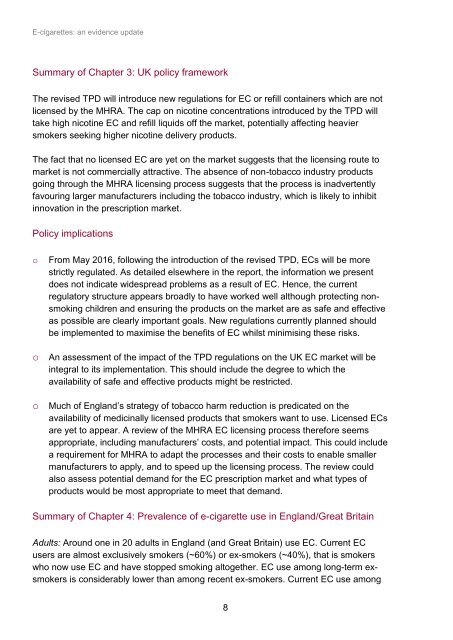E-cigarettes an evidence update A report commissioned by Public Health England
3nOaxpIe4
3nOaxpIe4
Create successful ePaper yourself
Turn your PDF publications into a flip-book with our unique Google optimized e-Paper software.
E-<strong>cigarettes</strong>: <strong>an</strong> <strong>evidence</strong> <strong>update</strong>Summary of Chapter 3: UK policy frameworkThe revised TPD will introduce new regulations for EC or refill containers which are notlicensed <strong>by</strong> the MHRA. The cap on nicotine concentrations introduced <strong>by</strong> the TPD willtake high nicotine EC <strong>an</strong>d refill liquids off the market, potentially affecting heaviersmokers seeking higher nicotine delivery products.The fact that no licensed EC are yet on the market suggests that the licensing route tomarket is not commercially attractive. The absence of non-tobacco industry productsgoing through the MHRA licensing process suggests that the process is inadvertentlyfavouring larger m<strong>an</strong>ufacturers including the tobacco industry, which is likely to inhibitinnovation in the prescription market.Policy implicationsoFrom May 2016, following the introduction of the revised TPD, ECs will be morestrictly regulated. As detailed elsewhere in the <strong>report</strong>, the information we presentdoes not indicate widespread problems as a result of EC. Hence, the currentregulatory structure appears broadly to have worked well although protecting nonsmokingchildren <strong>an</strong>d ensuring the products on the market are as safe <strong>an</strong>d effectiveas possible are clearly import<strong>an</strong>t goals. New regulations currently pl<strong>an</strong>ned shouldbe implemented to maximise the benefits of EC whilst minimising these risks.o An assessment of the impact of the TPD regulations on the UK EC market will beintegral to its implementation. This should include the degree to which theavailability of safe <strong>an</strong>d effective products might be restricted.o Much of Engl<strong>an</strong>d’s strategy of tobacco harm reduction is predicated on theavailability of medicinally licensed products that smokers w<strong>an</strong>t to use. Licensed ECsare yet to appear. A review of the MHRA EC licensing process therefore seemsappropriate, including m<strong>an</strong>ufacturers’ costs, <strong>an</strong>d potential impact. This could includea requirement for MHRA to adapt the processes <strong>an</strong>d their costs to enable smallerm<strong>an</strong>ufacturers to apply, <strong>an</strong>d to speed up the licensing process. The review couldalso assess potential dem<strong>an</strong>d for the EC prescription market <strong>an</strong>d what types ofproducts would be most appropriate to meet that dem<strong>an</strong>d.Summary of Chapter 4: Prevalence of e-cigarette use in Engl<strong>an</strong>d/Great BritainAdults: Around one in 20 adults in Engl<strong>an</strong>d (<strong>an</strong>d Great Britain) use EC. Current ECusers are almost exclusively smokers (~60%) or ex-smokers (~40%), that is smokerswho now use EC <strong>an</strong>d have stopped smoking altogether. EC use among long-term exsmokersis considerably lower th<strong>an</strong> among recent ex-smokers. Current EC use among8


